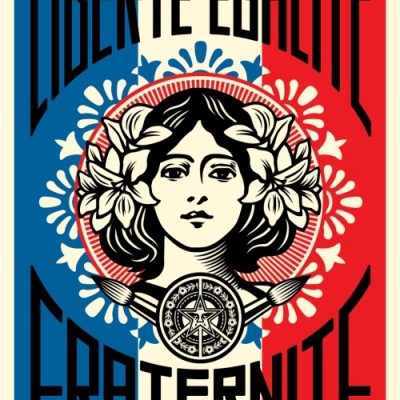Shepard spoke with Forbes while installing his latest Earth Crisis Globe at the Eiffel Tower and discussed politics, environmental activism, and what’s in store for the future. Read the blurb below and click more to read the full piece.
“In a lot of ways I feel like the project (Earth Crisis Globe) now has a greater degree of weight and I don’t know if I’m worthy. I’m always trying to use my art to create important conversations and this is a moment where there isn’t just one conversation to have. So I hope that looking at how interconnected things are, which is part of the aim of the piece, will encourage unity rather than fear and division. I wanted to come to France because I don’t want to live my life in fear. I think that for a very very small minority to hold the majority hostage in a sense, in their minds, is a terrible thing. So I wanted to be here.”
Street Artist Shepard Fairey Talks About His Artwork for the Eiffel Tower During COP21 in Paris
By: Rooksana Hossenally
In celebration of the COP21 World Climate Change Conference, the Parisian street art gallery Itinerrance has partnered up with the world-renowned and top-selling American street artist, graphic designer and committed environmental activist Shepard Fairey (also known as Obey). Together, they created ‘Earth Crisis’, an artwork if eight metres in diameter for the Eiffel Tower. The first street art project to be created on the Dame de Fer herself, this marks another turning point for street art and for the artist for whom this is “the ultimate coup”. Shepard Fairey talks about his work, environmental activism, empowering the people, reclaiming the meaning of the French flag, and the frivolity of US election campaigns.
RH: How do you feel about taking part in an art project in Paris at such a sensitive time?
SF: I know it’s a very tough time and I feel terrible for everyone that’s suffered because of terror; it reminds everyone that life is very fragile. I think in some ways that ties into this project about climate change because climate is about people looking at the collective good and the way we need to live in harmony; the idea that love and compassion are not just what the world needs but what the planet needs also. The beauty of art is that it can be intellectually provocative or challenging – I like that duality.
In a lot of ways I feel like the project now has a greater degree of weight and I don’t know if I’m worthy. I’m always trying to use my art to create important conversations and this is a moment where there isn’t just one conversation to have. So I hope that looking at how interconnected things are, which is part of the aim of the piece, will encourage unity rather than fear and division. I wanted to come to France because I don’t want to live my life in fear. I think that for a very very small minority to hold the majority hostage in a sense, in their minds, is a terrible thing. So I wanted to be here.
RH: What do you hope people will think when they see Earth Crisis?
SF: I hope that when people see the project they feel several things. I intentionally designed the image to have a connection to things from nature that appeal like floral, decorative motifs, mandalas that suggest harmony but woven within that are several cautionary images. I hope my piece has many dimensions just like the world does.
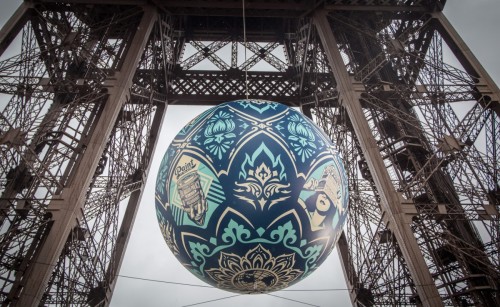
Earth Crisis will remain on the EIffel until 11th December 2015. Photo: Aline Deschamps
RH: You started out in street art in 1989. When did the environment become important to you?
SF: The first environmental images I did were in the mid-90s. My friend was an activist for the Sierra Club in Providence Rhode Island where I lived and he asked me if I could make some graphics for the student coalition. The Sierra Club is the student coalition at Brown University and in the US it’s a very powerful environmental organisation, very influential. As I became more educated about climate change, about the fossil fuel industries having very few barriers to doing whatever they want because of their lobbyists and their campaign contributions, I started to realise that the government that’s supposed to be preserving the quality of the environment, the quality of the air we breathe, the water we drink isn’t…
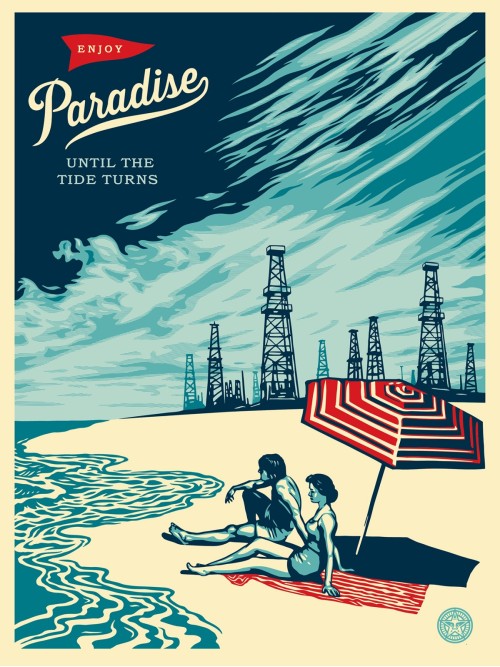
Paradise Turns – Shepard Fairey
If you take Bush’s policies, the war in Iraq, the patriot act, the shrinking freedoms, a lot of these things that I address in my work are actually related to each other so the problems with the environment also have to do with the way that political campaign financing works. The system is rigged to help the richest people. So all of these things are related to each other so a lot of my work is about justice towards the common good. The environment is one of those things, income and equality, health care, campaign finance reform to keep the corporations from having too much influence, all of those things are part of that goal of justice for the common person. But a lot of the US is unfortunately stubbornly resistant to science (laughs). Science is very inconvenient. Speaking of inconvience, 10 years ago when Al Gore’s Inconvenient Truth came out, it had a huge impact on me.
RH: Over the years have you been able to see the impact of your activism?
SF: That is always the challenge, reaching a critical mass. Do you know who Moveon.org is? I did a windmill campaign for them and they could see that it went over well with their membership because they sold a lot of prints as fundraisers for them to push the government to subside green or renewable energy. But that’s one of the things that is so frustrating; art can turn people onto an issue but sometimes that’s not enough in relation to the disinformation campaign that comes from companies saying things like ‘we make clean coal’ – there’s no such things as clean coal. Or scientists that go on Fox News and say things like there’s no proof that climate change is man-made but they’re paid to say these things. I do everything I can but that’s why I think it’s such a difficult thing…. They are very very powerful forces that make a tremendous amount of money destroying the planet. They’re thinking very short term, about quarterly profits, they’re not thinking about the next generation of people. It’s very selfish. It’s a time when humanity needs to be less selfish and if it doesn’t happen by choice it will be forced upon us.
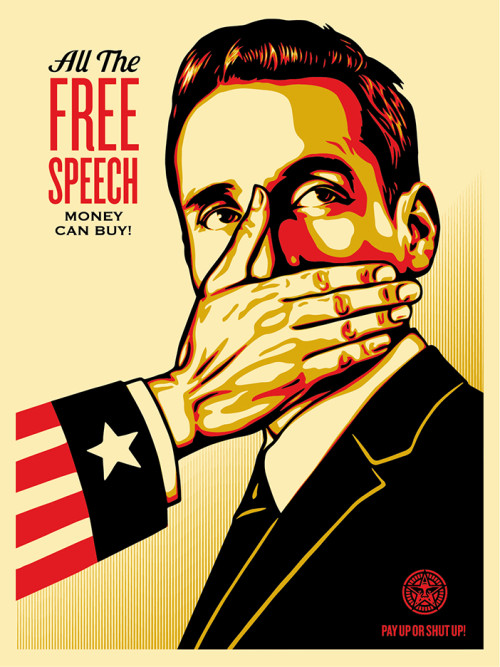
Shepard Fairey – ‘Pay Up or Shut Up’
SF: I’m stubborn (laughs). And I don’t want to feel powerless. It’s very important for me psychologically to always feel like even if I can’t see the results of an action immediately, every action matters and it’s something I try to put across in people through my work. Never underestimate your own power. You have things you can change in your own habits, in your own behaviour, but you also have an enormous amount of power just in having the courage to speak your mind, in speaking your mind and using the small tools that you have at your disposal as one human being and cumulatively makes a huge difference. But in the US voter turnout is only 30%; there’s a huge amount of apathy. So I’m essentially trying to fight apathy.
RH: Having a project on the Eiffel Tower is a prestigious opportunity, especially for you for whom public art is key. How do you feel about being present on a global landmark?
SF: I think the Eiffel Tower is extraordinary. The way it dominates the skyline, it’s beyond the cliché. I believe so much in the power of public art, and to have my work in a place that is one of the biggest public attractions of Paris it’s the ultimate expression of what I am trying to do which is trying to make art reach more people.
And some people argue about what is the right way to make street art is, whether it has to be guerrilla (without permission) but for me it was always about purely democratising art. I’ve always used the inside/outside strategy; if there is no way for me to do anything with integrity within the system I’ll work outside the system.
This project is kind of the ultimate coup for me as an artist that started on the outside but I think what it demonstrates is that someone like Mehdi (the director of Galerie Itinerrance) who has been able to make this project real but also transform the 13th district of Paris has contributed to validating street art as high art. Sometimes it’s just about finding the right translators. So much of culture, when you consider jazz, rock’n’roll, pop art, dada, impressionism – these things were all controversial when they started. People like Mehdi are saying that this kind of art form is important. So although I think what I’ve done for the Eiffel Tower doesn’t look like typical street art, many elements within it come from the language of street art and are elements that have been included in street art pieces I have done. So in a sense I am also very excited about exploring just how fine a line or how non-existent a line between low art and high-culture can be. There’s no barrier. But it’s all about understanding what works in different situations, contexts.
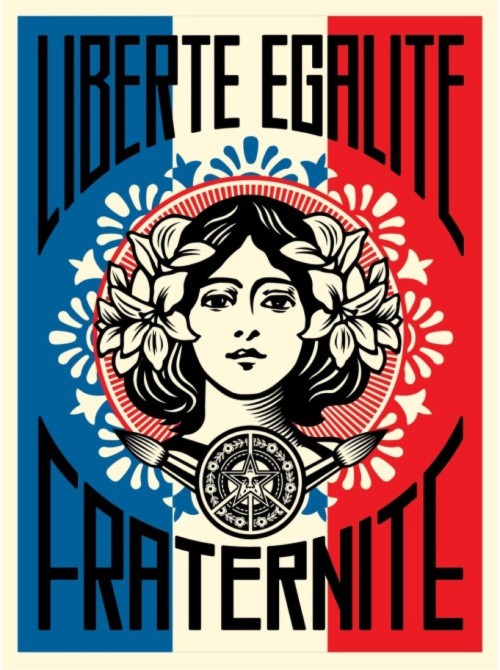
Liberté, Egalité, Fraternité – Shepard Fairey
RH: You made a poster with the French: Egalité, Liberté, Fraternité (Equality, Liberty, Fraternity). Why did you feel you needed to create one?
SF: The design is actually older. I created it because I have friends here in France. The first version I made in the US that said ‘Make art not war’ is 10 years old. What’s interesting is that the French flag has been projected around the world and some of my friends who are French said that this is one of the first times that there has been unity about the flag as a symbol – because it’s had fascist or imperialist connotations. I did this in the US, there’s the same thing with the US and the flag. So I did my version of the flag because I am a big fan of Jasper Johns but also to reclaim the flag to say there is huge amount of diversity within the US and the flag can’t just symbolise people who want to go to war, people who are conservative, so I did my version of the flag with symbols of all the religions, green energy, war, good and bad in my opinion but the diversity of what the US represents. I like that idea that the meaning of symbol can change depending on whose hands it’s in and how it’s used, the idea that the French flag can go from being seen as being about Nationalism to actually be about international support and unity. And this is a moment I want to show my support.
Now is the time to be more outspoken. Because most people will be afraid to say something that someone says isn’t appropriate but I think that’s the time when voices like Dick Cheney’s, he was not afraid to censor himself, they become the only voice in the conversation. I think that sometimes out fear people allow themselves to be manipulated. And I’ve seen the news about being in a state of emergency for three months. It’s a very sensitive thing because of course you want to make sure people are as safe as possible but also it’s very easy for abuse to happen when the usual laws or systems of due process are not in place.
RH: In a sense you’re a translator of what’s happening for the broader audience. How do you feel about that?
SF: I’m also involved in films being made about the environment like the 11th Hour. The narration was done by Leonardo Dicaprio. I recently did some work for This Changes Everything, a film made based on Naomi Klein’s book about capitalism versus climate change. So the thing that is great about making these images is I can communicate with my own audience but I can also help to make tools for other organisations like 350.org, Natural Resources Defence Council, the Sierra Club, etc. Creating images that they use to spread their message and raise money.
RH: Your ‘Hope’ poster for Obama’s campaign in 2008 went viral. Do you have any special projects underway for the next elections?
SF: Well, I like Bernie Sanders, but I’m not going to make a portrait of him, not because he’s not as photogenic as Obama (laughs), but because one of the things I realised that is one of the biggest problems in the US is that people treat political campaigns like a sports broadcast or reality television, it’s all about personalities. I’m trying to focus on principles in my work, and as ironic as that might be because art can be about the superficial, I’m more trying to seduce you or agitate you with the superficial to get you to think about the substantial. Now US campaigning is about what pant suit Hilary’s wearing or Trump’s hair. I really want to stay away from that and focus on the dynamics of the system because the players change but the machinery stays the same. The 2008 election was a special circumstance. I thought that Obama would actually be more transformative than he was. And in some ways I thought he was going to be a subversive infiltrator.
RH: And what do you think now?
SF: Now I think he’s a decent human being who did some things ok and others not so well but I’m proud of him for blocking the Keystone pipeline. There are other things where I don’t think he showed great leadership but it’s not up to one person; if you look at how the presidency works it’s very complicated because congress is so dysfunctional in the US. But the biggest issue that I see is that the citizenry is not informed enough because if the citizenry were more informed they would be pushing the politicians in ways that they aren’t now. And politicians think they can get away with pandering special interests with corporations because the public is not paying attention. So my goal is to reach the public about understanding these different issues rather than just think ‘Obama understands the issue so you don’t need to’. It’s challenging though.
RH: What’s next? Bigger walls? Something that runs against Donald Trump?
SF: I think Donald Trump will sink himself. With Bush it’s all about fear after 9/11. Dick Cheney and Donald Rumsfeld, they were all whispering in Bush’s ear. Americans were so fearful, we needed to go and ‘get somebody’, somebody was going to pay, we weren’t just sit there on our hands as a nation. It was really embarrassing I was ashamed of our country for supporting him. Those were very very dark times for the US.
RH: What’s next after the Eiffel Tower?
SF: He laughs… I’m going to Cuba to paint murals with Amnesty International. We haven’t decided on the content yet but it’s Cuba’s a place with such great history for art. There’s been a lot of isolation for Cubans so maybe I might make work that’s just about the next phase of open dialogue with the rest of the world.
Follow Rooksana Hossenally on Twitter (@RooksanaH) and Instagram (@_.Rox._)
